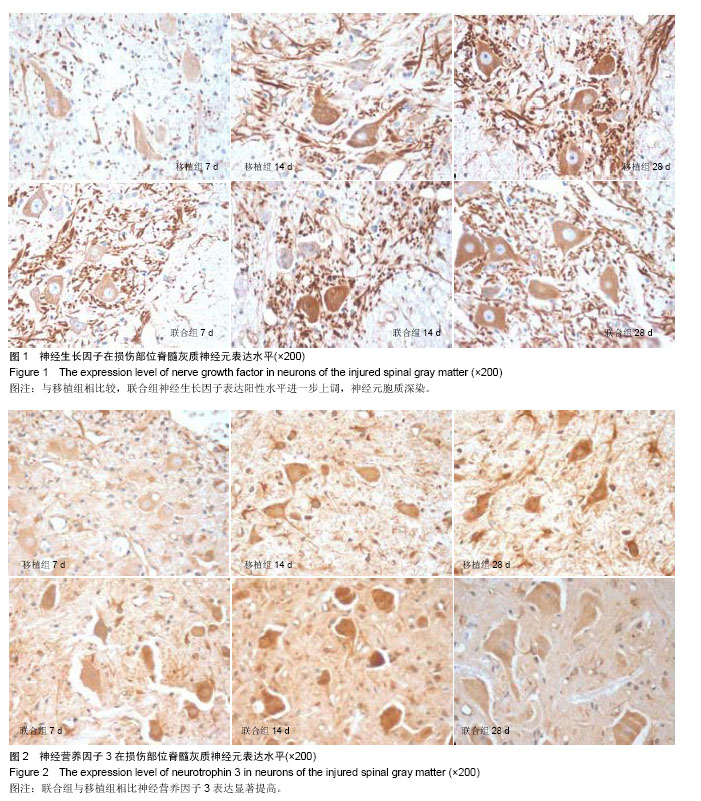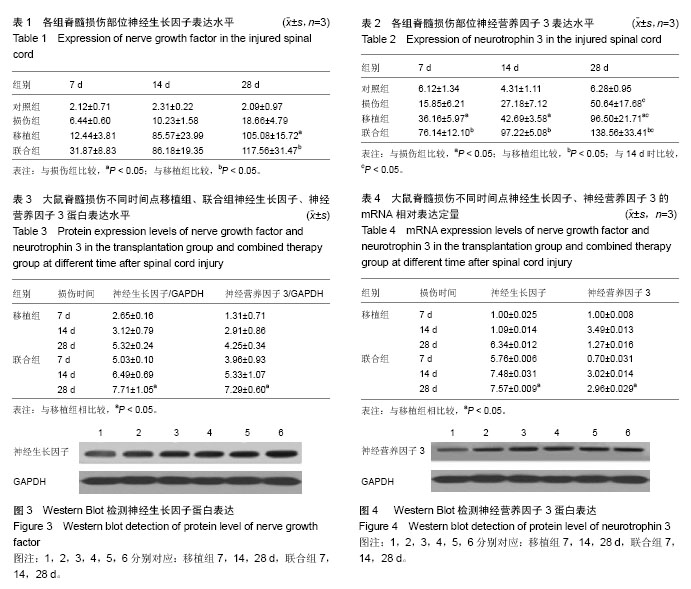设计:随机对照动物实验。
时间及地点:实验于2011年7月至2013年9月在滨州医学院烟台校区中心实验室完成。
材料:
实验动物:Sprague-Dawley雌性大鼠72只,6-8周龄,体质量220-250 g,由山东绿叶制药有限公司实验动物中心提供,随机分为4组:对照组、损伤组、移植组、联合组,每组18只。
脐血:新鲜的足月产妇脐血采自烟台毓璜顶医院,经产妇同意并排除传染性疾病及各种家族遗传病。
主要试剂:兔抗鼠NGF、NT-3抗体(1∶100),生物素标记山羊抗兔抗体(1∶200),兔抗大鼠抗体NGF IgG或NT-3 IgG(1∶400),均购于武汉博士德生物工程有限公司;山羊抗兔HRP IgG(1∶2 000),购于北京中杉金桥生物技术有限公司。
实验方法:
人脐血干细胞的分离、培养:在无菌条件下取正常足月产妇肝素抗凝脐血30 mL,脐血与PBS按1∶1混匀,加入5 g/L甲基纤维素按4∶1混匀,静止分层,取上清2 000 r/min离心5 min,弃上清,加入PBS制成单个细胞悬液,加入到相对密度为1.077的淋巴细胞分离液上,梯度离心(2 500 r/min,20 min),取细胞悬液层,加PBS制成单个细胞悬液,PBS洗涤2次,调整浓度为1.0×1011 L-1。
将收集到的细胞悬液按1.0×1011 L-1的浓度接种到 25 cm2培养瓶中,于37 ℃,含体积分数为5%的CO2培养箱内培养,3 d后更换培养基,去除未贴壁细胞。待细胞90%融合时以0.25%胰蛋白酶消化,进行传代培养。
Brdu标记脐血干细胞:选取第3代培养细胞,消化后以1.0×1011 L-1的浓度接种于6孔板中,放置过夜,加入终浓度为30 μmol/L的BrdU溶液,孵育40 min,PBS洗涤,40 g/L多聚甲醛固定60 min,进行免疫细胞化学染色鉴定,观察标记情况。
大鼠脊髓损伤模型制备及人脐血干细胞移植:损伤组、移植组和联合组采用脊髓全横断法制作大鼠急性脊髓损伤模型[14],对照组不做任何处理。麻醉、备皮,显露大鼠胸段脊髓(约T10水平),无菌刀片横断脊髓,即刻于脊髓横断处放置约1 mm×2 mm×2 mm大小、浸润人脐血干细胞悬液(细胞浓度为1.0×1011 L-1)的明胶海绵,损伤组采用浸润生理盐水的明胶海绵代替。术后定时排尿,加强日常护理。
电针治疗:联合组大鼠自模型完成1 h起采用督脉电针治疗:于损伤部位(T10)上、下取“大椎”“命门”穴,0.5 mm针,深达硬膜外并固定针刺位置。采用苏州华佗牌SDZ-Ⅳ型电子针疗仪,疏密波,频率4 Hz,调节刺激强度以目测大鼠后肢有轻微颤动现象为最佳,1次/d,每次30 min,直至取材。
标本取材与处理:①造模后7,14,28 d各时间点每组随机取3只行心脏灌注固定后取材,具体步骤:麻醉、暴露心脏,粗针自心尖穿刺进入主动脉,生理盐水冲净血液,40 g/L多聚甲醛灌注固定。后方分离多余椎板,暴露损伤脊髓,取损伤处头端长约1 cm脊髓组织,即刻中性甲醛溶液固定,石蜡包埋,备切片。②造模后7,14,28 d各时间点每组随机取3只大鼠进行新鲜取材,置-80 ℃冰箱冷存,以备提取蛋白及mRNA。
免疫组织化学分析:将每例标本石蜡切片,厚5 μm,常规脱蜡至水;暴露抗原;羊血清封闭;兔抗鼠NGF、NT-3抗体4 ℃过夜;生物素标记山羊抗兔抗体37 ℃ 30 min;DAB显色,苏木精染核,中性树胶封固,镜检,照相。
蛋白质抽提及Western blot分析:抽提损伤脊髓组织中神经生长因子、神经营养因子3的总蛋白,采用BCA方法测定蛋白含量。具体步骤为:依次灌好5%SDS聚丙烯酰胺凝胶电泳浓缩胶、8%SDS聚丙烯酰胺凝胶以用于电泳分离蛋白质,转蛋白至硝酸纤维素膜;5%脱脂奶粉封闭2 h;孵育袋内根据需要加入兔抗大鼠抗体NGF IgG或NT-3 IgG,4 ℃孵育过夜;TBS-T(含0.2% Tween20,20 mmol/L Tris-HCl,150 mmol/L NaCl,pH 7.4)洗膜3次,每次5 min;加入山羊抗兔HRP IgG,37 ℃,孵育1 h,TBS-T洗膜3次,每次15 min。胶片曝光、经显影、定影处理后观察结果,扫描,采用Image J软件分析。
RNA抽提及Real-time PCR:采用Invitrogen公司的Trizol试剂盒,根据说明书操作,提取脊髓组织中的总RNA,溶于20 μL DEPC-H2O,-80 ℃保存。
神经生长因子引物(290 bp):上游:5’-TCA TCC ACC CAC CCA GTC T-3’,下游:5’-GCC TGT CTG TCA TCT GTT G-3’;神经营养因子3引物(661 bp):上游:5’-CTT ATC TCC GTG GCA TCC AAG G-3’,下游:5’-TCT GAA GTC AGT GCT CGG ACG T-3’。同时对个别管家基因表达程度也进行检测,以观察样本间mRNA质量的差异,实验选择β-actin作为管家基因中的研究对象。β-actin引物(310 bp):上游:5’-ATC CCA TCA CCA TCT TCC AG-3’;下游:5’-ATG AGT GTC CTT CCA CGA TAC CA-3’,引物由上海博尚生物技术有限公司合成。按照Promega公司的一步法RT-PCR试剂盒说明进行操作。反应条件:45 ℃反转录 30 min;95 ℃变性2 min;(以下三步为PCR) 95℃变性30 s;50 ℃退火30 s;72 ℃延伸30 s;72 ℃最后延伸5 min;进行30个循环。1%琼脂糖凝胶电泳,成像分析。
主要观察指标:①免疫组织化学染色检测脊髓组织神经生长因子、神经营养因子3的表达水平。②Western-blot凝胶电泳检测脊髓组织神经生长因子、神经营养因子3蛋白表达水平。③实时荧光定量PCR检测脊髓组织神经生长因子、神经营养因子3的mRNA表达水平。
统计学分析:所采集数据均采用SPSS 13.0统计软件进行分析,设计相应的方差分析进行统计学处理,数据以 x±s表示。

